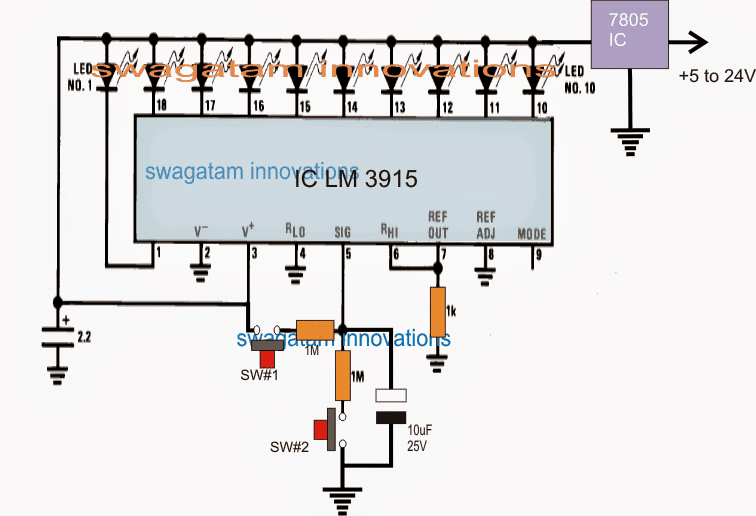This circuit can be used for moving an LED bar graph in the upward sequence or downward sequence through a couple of push button switches. The concept can be implemented for many other useful applications.
Using IC LM3915
In many circuit applications we require a digitally operated control system enabling an upward or downward control of a particular parameter, such as for controlling heat, sound volume, PWM, motor speed etc.
The application need may look straightforward but implementing it practically might not be that easy, unless specialized (hard to find) ICs are involved.
Here we'll see how the same may be achieved with the help of the IC LM3915 which is very commonly available across the globe and is reasonably cheap.


Understanding the proposed up/down LED sequence controller circuit using push button is very easy, and may be done by referring to the above figure.
How it Works
The image shows a LM3915 LED bar graph driver IC, configured in its standard mode.
Ten LEDs can be seen connected across the ten outputs of the ICs.
The LEDs are supposed to illuminate one after the other in a straight sequence from pin#1 to pin#10 of the IC, in response to a rising potential across its pin#5, meaning as long as the potential at pin#5 is zero, all the LEDs can be assumed to be switched OFF, and as the potential at pin#5 is increased, the LEDs may be seen illuminating sequentially from pin#1 until pin#10.
Pin#10 LED illuminates when the potential at pin#5 reaches about 2.2V.
The sequencing of the LEDs can be in the dot mode (when pin#9 is open) or in the bar mode (when pin#9 is connected with the positive supply).
In the above design since the pin#9 is not used or is unconnected, the sequencing of the LEDs are in the dot mode, meaning only one LED is lit at any instant across the relevant pinout of the IC.
For implementing the up or down sequence, SW#1 or SW#2 needs to be manually pressed.
When SW#2 is pressed, the capacitor across pin#5 of the IC is allowed to discharge slowly, causing the potential to drop gradually until may be it reaches 0V.
In response to this the LED sequence may be seen "running" backwards" from pin#10 to pin#1.
Conversely when SW#1 is pressed, the 10uF capacitor is allowed to get charged gradually which prompts the IC outputs to push the LED sequencing from pin#1 towards pin#10.
Thus the two push buttons may be appropriately pressed and released for achieving any one desired pinout of the IC to be in the active state, depending upon the charge level of the pin#5 capacitor.
The idea can be implemented for many other similar applications simply by integrating the control stage with the various pinouts of the IC in the required sequence.
that’s brilliant im so glad you have done this I now have the up down led controls for my power indicator on the startrek phaser type 2 im building fantastic this was the missing part now to put it all together.
Hi, the circuit does not work properly due to quick capacitor leakage.
you will need to add the following circuit at pin5 of the LM3915 to make it work correctly.
 " alt="up down touch switch control potentiometer" />
" alt="up down touch switch control potentiometer" />